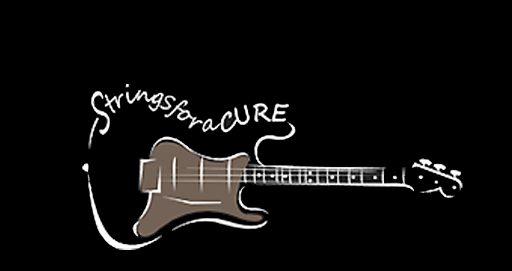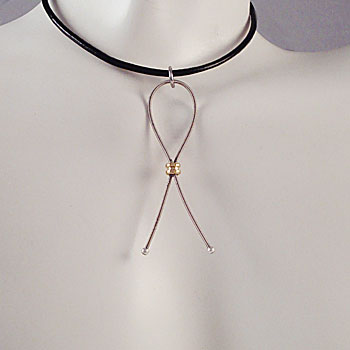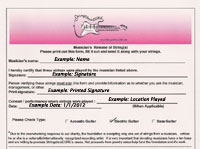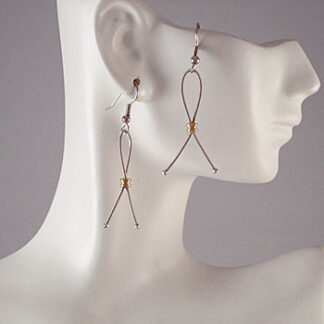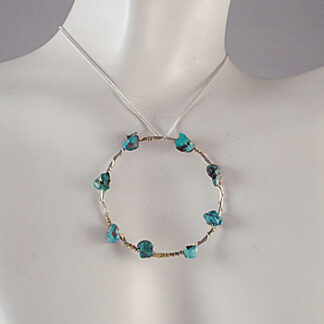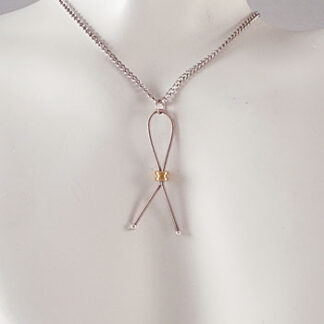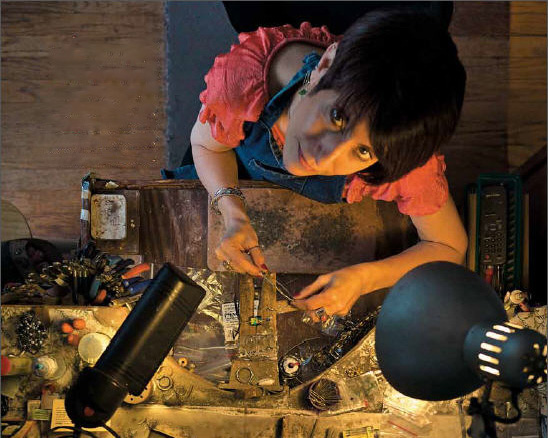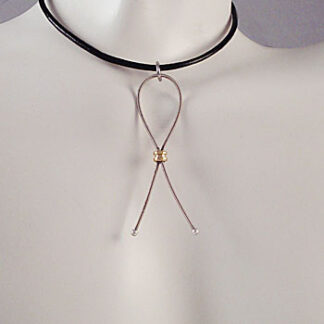Description
Awareness ribbon made out Buddy Guy’s used/played guitar string. Designed by jeweler and 2x breast cancer survivor Elisa Guida. Pendant is app. 2″ in length and contains the brass ferrule from Buddy’s string. Comes with a 16, 18, 20, 22 or 24″ finished leather chord with lobster clasp. Due to the high demand of the StringsforaCURE® jewelry, orders take 6-8 weeks to complete. These are hand made and may vary slightly.
Artist Release Form:
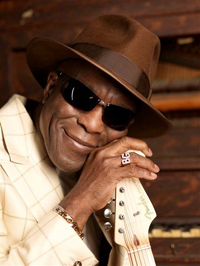 Buddy Guy is one of the titans of the blues, straddling traditional and modern forms, as well as musical generations. He’s worked with Muddy Waters, Little Walter and Howlin’ Wolf, on one hand, and Eric Clapton, Stevie Ray Vaughan and the Rolling Stones, on the other. There are few notable blues figures that Guy hasn’t brushed up against. He was even an influence on Jimi Hendrix. The genre’s most electrifying guitarist, Guy has remained a vital and current musician, moving blues forward without losing sight of its roots. He’s renowned for his raw, blistering vocals and high-voltage guitar playing. His plays a Fender Stratocaster, employing feedback, distortion and extreme string-bending. He spent much of the Sixties on the venerable Chess label and thereafter recorded for Vanguard, Atco, Silvertone and others. Guy attained great stature within blues circles over the course of three decades, but his career broke wide open in 1991 with the release of Damn Right, I’ve Got the Blues. This landmark release won him a Grammy and five W.C. Handy awards, and he recorded and toured prolifically in its wake. Clapton has proclaimed Guy “by far without a doubt the best guitar player alive… He really changed the course of rock and roll blues.” Guy regards himself as a “caretaker of the blues.” Having learned from the likes of Waters, Otis Rush, Guitar Slim and Magic Sam, he explains, “I just take what they taught me and keep adding to it.” George “Buddy” Guy was born in 1936 in Lettsworth, Louisiana. His earliest influences included T-Bone Walker, Lightnin’ Slim and Lightnin’ Hopkins – blues musicians who were all uniquely expressive stylists and showmen. Guy’s high-energy showmanship also owed a debt to Guitar Slim (a.k.a. Eddie Jones), of “The Things That I Used to Do” fame. As Guy stated in his autobiography, “I wanted to play like B.B. King but act like Guitar Slim.” Along the way, he developed his own style, typified by a fierce staccato attack and tense single-note solos. He spent a year and a half playing with John “Big Poppa” Tilley’s band in Baton Rouge. After sending a tape to Chess Records, Guy headed to Chicago in 1958 to seek his fortune. He drew attention on the club circuit for his fiery fretwork and showmanship. With assistance from his friend and fellow bluesman, Magic Sam, Guy got signed to Cobra Records (releasing a few singles on its Artistic subsidiary). A year later Cobra folded and Guy – along with labelmates Willie Dixon and Otis Rush – moved to Chess, where he played recorded from 1960 to 1967. Guy’s Chess sides never won the recognition that accrued to some of his labelmates, but he scored a hit with “Stone Crazy,” his fourth single for the label. In an edited version (the original ran for seven minutes), it went to Number 12 R&B in 1962. Another highlight of his Chess tenure was “When My Left Eye Jumps,” a menacing slow blues penned by Willie Dixon. While at Chess, Guy also served as an in-house guitarist, playing on sessions for Muddy Waters, Howlin’ Wolf, Little Walter, Koko Taylor and others. Notably, he performed on Koko Taylor’s “Wang Dang Doodle” and Howlin’ Wolf’s “Killing Floor.” Taking notice of the evolving blues-rock scene in England, Guy left Chess in 1968 and moved to Vanguard Records, where he cut the classic albums A Man and His Blues and Hold That Plane. In 1970, Buddy and the Juniors (a trio of Guy, harmonica player Junior Wells and pianist Junior Mance) was released on Blue Thumb. Guy’s partnership with Wells yielded the 1972 album Buddy Guy and Junior Wells Play the Blues. A spontaneous, tradition-minded blues set, it was produced by the impressive triumvirate of Eric Clapton, Ahmet Ertegun and Tom Dowd, and released on Atco Records. Rolling Stones bassist Bill Wyman produced and played on the Guy-Wells live album Drinkin’ TNT ‘n’ Smokin’ Dynamite, recorded in 1974. Although he continued to perform, Guy’s recording career stalled somewhat in the Eighties. In 1989, he opened the blues club Legends in Chicago, which became a favorite hangout for blues musicians. Guy’s comeback began when he joined Eric Clapton onstage at London’s Royal Albert Hall during the guitarist’s multi-night run in 1990-91. That exposure led to a new recording contract. Damn Right, I’ve Got the Blues was the first of many albums on the Silvertone label and ignited a full-blown renaissance that made Guy the preeminent blues guitarist of the Nineties. In fact, Damn Right, I’ve Got the Blues became that rarity: a blues accord that sold well enough to earn a gold record (500,000 copies sold). The star-studded album included cameos by such acolytes as Eric Clapton, Jeff Beck and Mark Knopfler. Two years later, he released Feels Like Rain, which included contributions from Bonnie Raitt, Travis Tritt and John Mayall. Later that same year, Guy received the prestigious Century Award “for distinguished artistic achievement” from Billboard magazine. Well into his 70s, Guy is still going strong. Recent releases have included Sweet Tea, an electric blues album recorded in Mississippi; and Blues Singer, a 2003 acoustic set in which Guy covers favorites by such peers as Skip James, Son House and John Lee Hooker. – See more at: https://rockhall.com/inductees/buddy-guy/bio |
